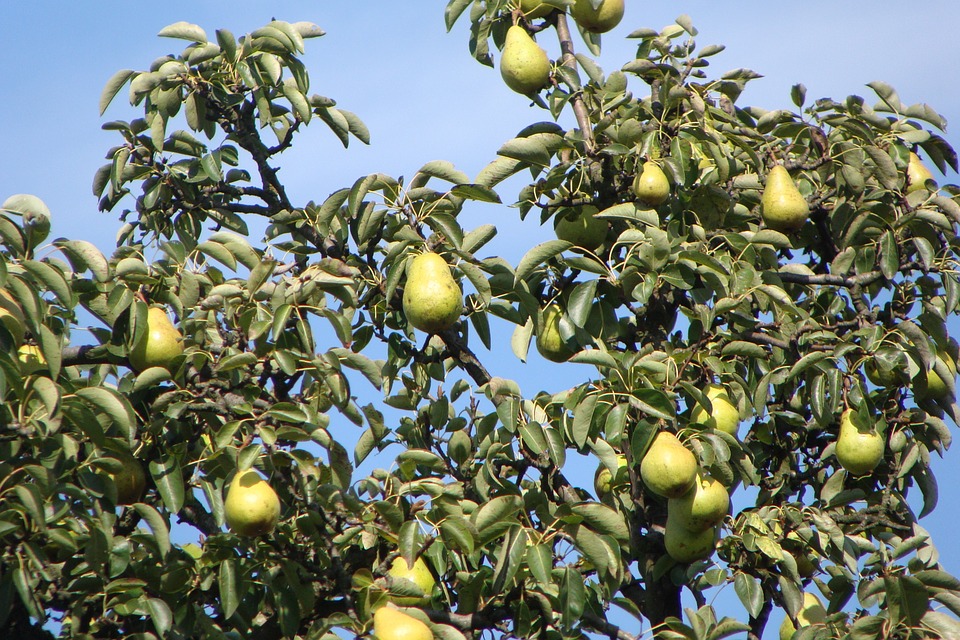This article provides a comprehensive guide for pet owners on whether dogs can safely enjoy pears and the potential benefits and risks associated with this fruit. We'll explore the nutritional value of pears for canines, discuss safe serving sizes and preparation methods, and address common concerns about pear consumption in dogs. By understanding the details, you can make informed decisions about incorporating pears into your dog's diet.
Part 1: The Nutritional Value of Pears for Dogs

1.1 Vitamins and Minerals: A Nutritional Powerhouse
Pears are a good source of essential vitamins and minerals that can benefit your dog's health. They contain:
- Vitamin C: An antioxidant that supports immune function, helping your dog fight off infections and stay healthy. Vitamin C also plays a role in wound healing and collagen production.
- Vitamin K: Essential for blood clotting and bone health, ensuring proper blood coagulation and supporting strong bones for your canine companion.
- Potassium: Plays a role in muscle function and nerve transmission, contributing to your dog's overall energy and coordination. Potassium is also important for maintaining healthy blood pressure.
- Fibre: Promotes healthy digestion and helps regulate bowel movements, preventing constipation and promoting regular digestion.
1.2 Antioxidants: Fighting Free Radicals
Pears are rich in antioxidants, which can help protect your dog's cells from damage caused by free radicals. These antioxidants contribute to overall health and may help prevent chronic diseases. Antioxidants can help protect your dog's cells from oxidative stress, which can contribute to aging and disease.
1.3 Low in Calories: A Healthy Treat Option
Pears are relatively low in calories, making them a suitable treat for dogs who need to maintain a healthy weight. This makes them a good alternative to high-calorie treats that can contribute to obesity.
Part 2: Are Pears Safe for Dogs?

2.1 General Safety: Moderation is Key
In general, pears are safe for dogs to eat in moderation. However, there are certain considerations to keep in mind to ensure their safety.
2.2 Potential Risks: Understanding the Cautions
- Pectin: Pears contain pectin, a soluble fibre that can cause digestive upset in some dogs if consumed in large quantities. This can manifest as diarrhoea or gas, especially in dogs with sensitive stomachs. It's important to introduce pears gradually and observe your dog's reaction.
- Seeds and Core: The seeds and core of pears contain cyanogenic glycosides, which can be toxic to dogs. These compounds can release cyanide when ingested, which can be harmful to your dog's health. It is crucial to remove these parts before offering pears to your dog. Never allow your dog to eat the core or seeds of a pear, even in small amounts.
- Sugar Content: Pears are moderately high in sugar. While this is not typically a concern for healthy dogs, it's important to be mindful for dogs with diabetes or weight management issues. Excessive sugar intake can lead to weight gain and exacerbate health conditions like diabetes.
Part 3: How to Feed Pears to Your Dog Safely

3.1 Serving Size: Individual Needs Matter
The appropriate serving size of pears for dogs depends on their individual size and weight. Start with a small piece, such as a slice or a few cubes, and observe your dog's reaction.
- Small dogs: Start with a single slice, about the size of a quarter.
- Medium dogs: Offer a few small cubes, about the size of a dice.
- Large dogs: You can increase the portion size slightly, but still keep it moderate.
3.2 Preparation: Ensuring Safe Consumption
- Remove the seeds and core: This is essential to prevent potential toxicity. Thoroughly remove all parts of the core and seeds before offering pear to your dog.
- Slice or cube: Cut the pear into bite-sized pieces for easier consumption, reducing the risk of choking. Small pieces are easier for dogs to digest.
- Cooked or raw: You can offer pears to your dog cooked or raw, but raw pears are typically preferred as they retain more of their nutrients. Cooked pears can be a good option for dogs with sensitive stomachs.
- Avoid peels: While not poisonous, peels can be difficult for dogs to digest and may cause choking hazards. The peel can be hard and difficult for dogs to break down, potentially causing digestive problems.
3.3 Frequency: Treats, Not Meals
Pears should be treated as an occasional treat rather than a staple food. Offering pears too frequently can lead to digestive issues or weight gain. Limit pear servings to once or twice a week, as part of a balanced diet.
Part 4: Signs of Pear Toxicity in Dogs
4.1 Symptoms: Identifying Potential Problems
If your dog has consumed too much pear or ingested the seeds or core, they may exhibit symptoms such as:
- Vomiting: This is a common reaction to ingesting too much of a new food, or to consuming the toxic parts of the pear.
- Diarrhoea: Pectin can cause loose stools, especially in dogs with sensitive digestive systems.
- Gas: This can occur due to the fermentation of sugar in the digestive tract.
- Abdominal pain: This may indicate an upset stomach or discomfort due to ingestion of the core or seeds.
- Lethargy: A lack of energy can be a sign of a general unwellness.
- Loss of appetite: This may indicate nausea or pain associated with pear ingestion.
- Difficulty breathing: This is a serious symptom and requires immediate veterinary attention, as it can be a sign of cyanide poisoning.
4.2 Seeking Veterinary Attention: When to Act
If your dog experiences any of these symptoms after eating pears, it's essential to contact your veterinarian immediately. Prompt action can help prevent serious complications. Be sure to note the amount of pear your dog consumed and whether they ate the core or seeds.
Part 5: Alternatives to Pears for Dogs
If you're looking for other healthy and safe fruit options for your dog, consider these alternatives:
- Apples: Apples provide similar nutritional benefits to pears and are generally safe for dogs, but ensure to remove the seeds and core. Choose varieties like Granny Smith, which are lower in sugar.
- Bananas: Bananas are rich in potassium and fibre, making them a good choice for canine companions. Offer them in moderation, as they are higher in sugar than some other fruits.
- Blueberries: Blueberries are packed with antioxidants and are considered a healthy treat for dogs. These tiny berries are a great source of vitamins and fibre.
- Strawberries: Strawberries are another excellent source of antioxidants and can be enjoyed in moderation. These sweet berries are also a good source of vitamin C.
Part 6: Choosing the Right Pears for Your Dog
6.1 Organic Pears: Minimizing Pesticide Exposure
Organic pears are generally considered a safer option for dogs, as they are free from pesticides and other harmful chemicals. Choosing organic reduces the risk of your dog consuming harmful residues.
6.2 Ripe Pears: Easier Digestion
Ripe pears are easier for dogs to digest and are less likely to cause digestive upset. Ripe pears have a softer texture, making them easier for dogs to chew and digest.
Part 7: Storing Pears for Your Dog
7.1 Refrigerate: Maintaining Freshness
Store pears in the refrigerator to prolong their freshness and prevent spoilage. Refrigeration helps keep pears fresh for longer, ensuring their quality when you serve them to your dog.
7.2 Cut and Store Separately: Preventing Contamination
If you're offering sliced pears to your dog, store the remaining portions in an airtight container in the refrigerator. This helps prevent contamination and keeps the slices fresh.
Part 8: FAQs
8.1 Can puppies eat pears?
Puppies can typically enjoy pears, but it's best to consult your veterinarian about appropriate serving sizes and frequencies. Puppies have smaller digestive systems and are more sensitive to changes in their diet.
8.2 Can dogs eat pear skin?
While pear skin is not poisonous, it can be difficult for dogs to digest and may pose a choking hazard. It's best to remove the skin before offering pears to your dog. The peel can be tough and difficult to break down, potentially leading to digestive problems.
8.3 Are pear leaves poisonous to dogs?
Yes, pear leaves contain cyanogenic glycosides, which are toxic to dogs. Keep pear leaves out of reach of your furry friend. The leaves contain higher concentrations of the toxic compound than the fruit itself.
8.4 Can I feed my dog pear juice?
Pear juice is not recommended for dogs due to its high sugar content. It's best to stick to the whole fruit for a more natural and balanced treat.
8.5 How much pear can I feed my dog?
The appropriate serving size of pears for dogs depends on their size and weight. It's best to start with a small piece and monitor their reaction. Use the guidelines provided earlier in the article based on your dog's size.
8.6 Are all types of pears safe for dogs?
Most pear varieties are safe for dogs, but avoid offering exotic or unusual types unless you're certain of their safety. Stick to common pear varieties that are readily available in your local market.
By adhering to the guidelines outlined in this article, you can confidently incorporate pears into your dog's diet and enjoy the benefits of this delicious and nutritious fruit. Remember to always consult your veterinarian if you have any specific concerns or questions regarding your dog's health and diet.
Everyone is watching
-

Can Dogs Eat Bananas? A Guide to Safe Treats
DOGS & PUPPIESThis comprehensive guide will delve into the world of canine nutrition, focusing on the popular question: can ...
-

Can Dogs Eat Oranges? (Is It Safe or Toxic?)
DOGS & PUPPIESThis article delves into the question of whether dogs can safely consume oranges. We'll explore the nutrition...
-

Can Dogs Eat Grapes? The Shocking Truth About This Fruit
DOGS & PUPPIESThis article delves into the controversial topic of grapes and dogs, exploring the potential dangers associate...
-

Why Do Dogs Eat Poop? Understanding Coprophagia in Dogs
DOGS & PUPPIESThis article delves into the perplexing phenomenon of coprophagia, the act of eating faeces, in dogs. We explo...
-

Can Dogs Eat Shrimp? A Guide to Safety and Risks
DOGS & PUPPIESThis comprehensive guide dives into the world of shrimp and dogs, exploring the potential benefits and risks a...
